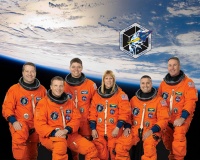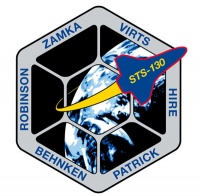STS-130
From The Space Library
 | |
| Organization | National Aeronautics and Space Administration (UnitedStates) |
|---|---|
| Mission type | Human Crew,Resupply/Refurbishment/Repair |
| Launch date | February 8, 2010 |
| Launch vehicle | Space Shuttle |
| Launch site | Cape Canaveral, United States |
| COSPAR ID | 2010-004A |
| Inclination | 51.6 degrees |
| Experiments | Here |
| Alternate Names | 36394 |
| Additional Information | Here |
| Data Collection | Here |
| Payload Mass Up | 15844.43 kg |
| Payload Mass Down | 702.27 kg |
| Orbiter | Endeavour |
| Lift Off Mass | 2,055,527.27 kg |
| Orbiter Weight at Liftoff | 121,667.73 kg |
| Orbiter Weight at Landing | 91,455.91 kg |
| Landed | 10:20 p.m. EST, concrete runway 15, Kennedy Space Center, Fla. |
| Orbits of Earth | 217 |
| Orbital Altitude | 185 nautical miles |
Contents |
Crew
- Commander: George D. Zamka
- Pilot: Terry W. Virts Jr.
- Payload Commander:
- Mission Specialist 1: Robert L. Behnken
- Mission Specialist 2: Kathryn P. Hire
- Mission Specialist 3: Nicholas J.M. Patrick
- Mission Specialist 4: Stephen K. Robinson
- Mission Specialist 5:
- Payload Specialist 1:
- Payload Specialist 2:
ISS/Mir Crew Transport
Mission
STS 130 was an American shuttle craft carrying six astronauts, hardware and a module for the International Space Station. It launched from Cape Canaveral on 08 February 2010 at 09:14 UT. The craft docked with the ISS on 10 February 2010 at 05:06 UT. The mission objectives included installation of the Tranquility module, with its attached cupola, to the ISS Unity module, as well as the transfer of supplies, hardware and experiments to the ISS. The STS-130 mission completed with a landing at Cape Canaveral on 22 February 2010 at 03:20 UT.
EVA
Extravehicular Activity (EVA) conducted by Robert Behnken and Nicholas Patrick during three spacewalks for a total of 18 hours, 14 minutes. Kathryn Hire and Terry Virts removed Tranquility from Endeavour's payload bay using the station's robotic arm and positioned it on the port side of the Unity module. Tranquility was then locked in place via 16 remotely controlled bolts. EVA 1, 6 hours, 32 minutes; Behnken and Patrick relocated a temporary platform from Dextre to the truss structure and installed two handles on Dextre. Once Tranquility was structurally mated to Unity, Behnken and Patrick connected heater and data cables to integrate Tranquility with the rest of the ISS systems. EVA 2, 5 hours, 54 minutes; Behnken and Patrick connected ammonia coolant loops, installed thermal covers around the ammonia hoses, outfitted the Earth-facing port on Tranquility for the relocation of its Cupola, and installed handrails and a vent valve on the new module. Hire and Virts subsequently moved the Cupola from its launch location to the Earth-facing side of Tranquility using Canadarm2. EVA 3, 5 hours, 48 minutes; Behnken and Patrick removed insulation blankets and launch restraint bolts from each of the Cupola's seven windows. They also installed handrails on Tranquility and relocated a foot restraint.
Payload
ISS Assembly Flight 20A; Node 3 "Tranquility," the final U.S. pressurized module; and the Cupola, a robotics work station with six windows around its sides and another in the center that provides a 360-degree view around the ISS
Books about the Space Shuttle Program
Buy This Book Click here |
Buy This Book here |
Buy This Book Click here |
Buy This Book Click here |





